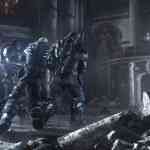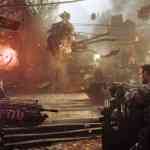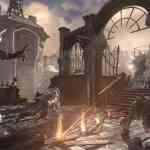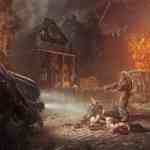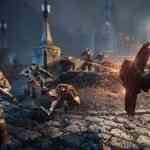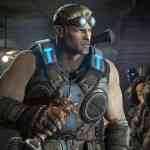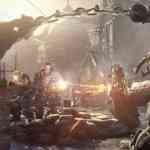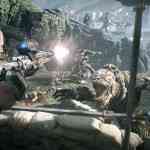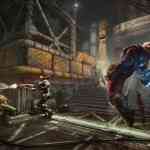Gears of War has become quite the behemoth of a franchise since the first game was released in 2006. There have been a total of 19 million copies of Gears of War games sold overall and it has generated more than a billion dollars in sales. Yes, those facts are from an official fact sheet, but what I am trying to get at by repeating these is that the Gears franchise is very popular franchise, exclusive to Microsoft, and it has been a showcase for the power of the Xbox 360 and Epic’s Unreal engine. The next game in the series, Gears of War: Judgment is a brand new story with developer People Can Fly, who made Bulletstorm, taking the lead with assistance from series originator Epic Games. Well Judgment in its own right is a fairly good game, I have to say that I couldn’t shake the feeling like I had ‘been-there-done-that’ before while also hitting a few areas where I just didn’t know why they did what they did.
The story of Judgment is set before the original events of the Gears Trilogy. You will take control of Kilo Squad, who is led by Gears franchise veteran Lt. Baird. Along for the ride is another franchise staple, Augustus “Cole Train” Cole. They are joined by new cast members Sofia Hendrik (a COG Recruit) and Garron Paduk (a former UIR soldier). As game trailers have shown us, Baird and the rest of Kilo Squad are being tried by a tribunal of some sort. What they are accused of is something I will not mention here, as you’ll have to play the game to find out as I am not allow to, nor would I want to, spoil it. Without giving too much away the first four chapters you play are from the eyes of each main character who is testifying at the time. First you’ll play as Baird, then as Sofia, then as Paduk, then finally as Cole. It is an interesting story telling technique as each character narrates the events to the tribunal while you are playing through it. Each chapter of the story has an ‘angle’ to it depending on who is narrating it. Playing through these first four levels sets you up the final two levels that round out a total of six.
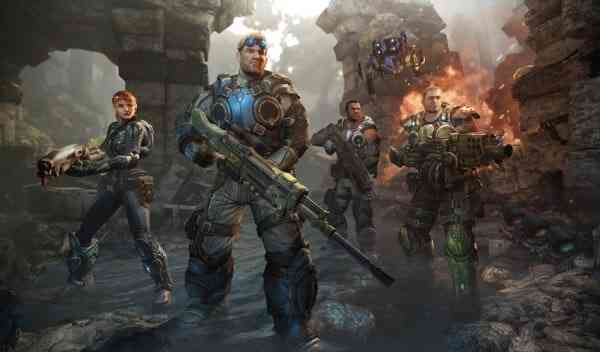
The narrative is an interesting one, but I have to say that there are no “holy cow” moments during the story. Don’t get me wrong, there will be a surprise here and there, but I have to say that the story just didn’t grab me as much as I thought it would. Yes, I still enjoyed it, but after everything was said and done, and the final ending was complete, I was like “That is it?” I found that I wanted more back story on the two new characters that would pertain to their history so to speak. There is also not enough of about Baird and Cole during this specific time period right after “Emergence Day”. This may not bother some people, but I couldn’t help wanting to be greedy in this area and know even more.
If there is one thing that is clearly evident is that this is a Gears game, but on steroids. There is so much of what makes Gears that fans of the first three games will settle in quite quickly. The one thing that fans will notice though is that the game is more “crazier” as there is so much more happening on screen at once. This really hit home to me during a rooftop level where you make your final stand at the end of it. There was so much going on and so many enemies bearing down on my location that it was almost overwhelming at times, and this was on ‘normal’ difficulty. Given that People Can Fly developed the action shooter Bulletstorm, which was known for its over the top action using the Unreal Engine, it almost makes sense that you’d see more action in Judgment. This brings me to one of my biggest complaints, there are too many “defend the point” sequences throughout the game. It was almost like playing a single player Horde mode over and over again. The majority of the levels had at least one of these, and I found it took away some of the shine of the game. It was almost like they put these sequences in the game in order to make it last a little longer. I found that I could have done with a lot less of these and more action that told the story.
There are a couple of new elements added to the gameplay in this latest Gears. As you play through each level you are awarded up to three stars for your effort. Attaining stars isbased on number of kills, whether or not you are downed and need to be revived, types of kills, special moves or kills such as headshots or executions, and if you earn any ribbons. This is where one of the bigger additions to Judgment comes to play. It is a new feature called the Mission Declassification system. When I first heard of this I thought they were new side missions, but alas they are new gameplay scenarios within the level you are playing that make the game harder and more rewarding. Should you accept these challenges specific things change or are required for that section of the level. For example, you’ll have to play during a dust or wind storm, affecting your vision and your ability to shoot straight, or you will have to start with little to no ammo. You’ll also find yourself having to complete certain sections of levels within certain time limits, and should you not ‘beat the clock’ you face immediate death. As you play the Declassified Mission scenario in each section of each level you earn your three stars quicker and much more efficiently.
One of the neat things about the stars you earn is not only do you get some appreciated achievements as you play, but once you get 40 of these stars you open up a new playable chapter called Aftermath. This chapter is separate of Judgment’s main campaign and connects some of the events in Gears of War 3; most notably, there is a scene in Gears of War 3 where after a particular key battle Baird and Cole are sent by Marcus Fenix to get some recruits, but they are not seen for the majority of Gears 3. Aftermath tells the story of what happened during that time period. It is a neat feature and lasts about as long as each chapter you play during the campaign for Judgment. It wraps up some unanswered questions too and Gears fans will appreciate the fan service.
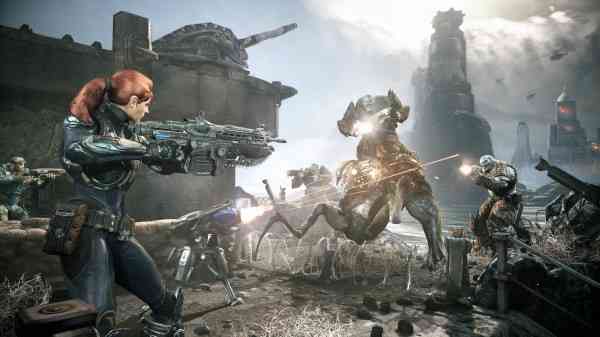
Another new feature that has been added to the Judgment is a spawning feature that the developers have called the Smart Spawn System (S3). The official word is it “…ensures that each encounter is unique and new because types, timing and locations of enemies change with each new encounter”. Well I have to say that this system works as described. A few times after dying during one part of one level, when I respawned there was a whole different set of enemies resulting in a whole new set of challenges. First there was regular Locusts and a few Grinders, then when I started again, there were some Boomers and Scorchers that were not originally there. It was neat to see things change up like this and made it so you would not face the same enemies in the same spots each time through. Pretty neat stuff and it works.
I was surprised that Judgment is not particularly long. I was able to finish it in a day. It took me around 6 hours and that was in Normal mode exploring a bit and repeating a few sections of certain levels. This game may last anywhere from 5 – 8 hours depending on your skill level, and how much exploration you do, and I feel that I am being generous. Now, I may not have the best memory, but I don’t remember plowing through any of the first three games that quickly. I remember having to play over a few days to get them done. In the end Judgment just didn’t feel like any FULL Gears campaign that I have played in the past. Also worth noting is that you’ll find that after specific sections of each level, you are scored for your progress (the aforementioned stars). This takes you out of the story somewhat as you are scored a lot during each level and it seems kind of out of place.
As you play through either the campaign or online (co-op or adversarial) you level up. This is based on your performances in any of the modes as well as how creative you are with your kills. You max out at level 50 but you can start again. Doing so earns you achievements. Judgment also has collectibles like the previous games in the form of COG tags (48 in total) that are hidden throughout the levels you venture through. Collect these and you once again earn some achievements.

Along with the single player campaign there are various multiplayer modes, including cooperative and adversarial. In regards cooperative you can play through the complete campaign with up to three other gamers. To tell you the truth I think the campaign is more enjoyable this way as you can share the events and craziness together. The other cooperative mode is a new mode, similar to Horde mode, called Survival. The objective of surviving through ten waves of harder Locust enemies stays the same, but the new aspect is that there are now class based characters. You can play as an engineer, medic, soldier or scout, and each have different abilities and weapons. For instance, an engineer has a blowtorch to fix damaged fortifications, a solider can supply ammo, a medic can throw “Stim Grenades” to heal players, and the scout can climb perches. At the end of the day this is basically an enhanced Horde mode and more or less the same thing you’ve played before. Regardless, you will find it fun with your friends online.
Judgment offers up a full suite of adversarial multiplayer modes. OverRun is the biggest edition as players use the new classes of COG players while there are separate classes for the enemy Locusts you battle. Here you’ll find objective based play and teams alternate between playing as COG and Locusts. Domination is a five vs. five mode where each team tries to control three rings placed on the map. You can think of this as a “King of the Hill” mode. Free for all is exactly what the name implies; however, this time it is COG vs. COG to see who comes out on top. Finally there is Team Deathmatch, a mode that does not need any introduction. I didn’t get nearly as much multiplayer playtime as I had hoped, but I have to say that if you have played any Gears online in the past then you should enjoy this. The battles get heated, and the new class based modes are pretty slick. What I did get to play was fun, there is no doubt about it, and I can’t wait for my friends to pick up the game to play online with me. Lag was not an issue when I played, but that being said, the game was not out to the public at the time, so online traffic was not an issue.
I have to say that visually Gears of War: Judgment looks like it is using every bit of horsepower that the Xbox 360 has; in other words, it looks damn good. Right from the start you can see that the presentation and visual quality is top-notch as the opening cutscene leads into gameplay seamlessly and without any visual difference. I really think we are at a point in gaming where developers have the ability to make the gameplay look the same as the cutscenes used to tell the story. As you play you will notice that each major chapter is broken up into various areas and they never seem to look alike. From the opening scene of a Halvo Bay and museum, to the buildings and inside halls of the COG Academy, to the beach and fortress like structure of Onyx Bay, everything has its own look and design. One level that was actually quite impressive had Kilo Squad navigating across the rooftops of Halvo Bay and it was pretty impressive to look into the endless distance of the buildings and destruction that was a result of “Emergence Day”.
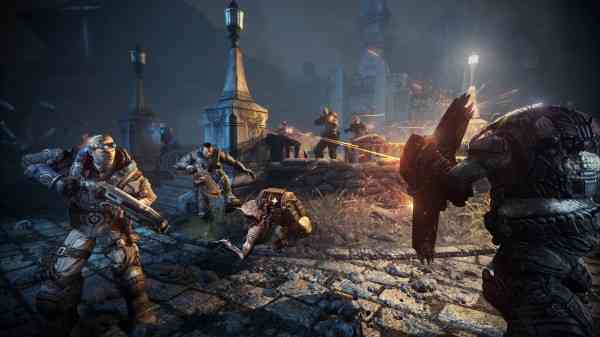
It would not be a Gears game without Epic’s powerful Unreal Engine, and here you’ll find lots of eye candy. The lighting and shadowing are front and center, as are fire and explosion effects. In regards to the lighting, while on the aforementioned rooftops, with the sun ever so low behind, the shadows that were cast by the members of Kilo Squad were pretty impressive. Not to be outdone though are the fire effects which you will come across many, and of course let’s not forget the copious amounts of explosions, smoke, and dust too. Without so much as missing a beat the game goes on without any technical hitches. During my play through I only hit one brief moment of slowdown, yep, just one, and the rest of the game was pretty much trouble free. Pretty impressive, but not something unexpected, as Gears of War 3 was a very visually sound game technically speaking.
As with the visuals the sound in Gears of War: Judgment is just as good. You’ll find the voice acting just as strong as it has been in the past, with some interesting dialog from Kilo Squad, old and new members alike, as well as some great radio chatter from a voice or two you may just recognize from games earlier in the franchise’s history. As for the music, I found it very impactful throughout the game. It had just the right intensity at just the right moment, be it during the story telling moments or during those times when things got really crazy in battle or when a new enemy or group of powerful Locusts would hit you and your squad all at once. Finally, sound effects wrap up the audio package with a nice neat bow. From the oh so familiar sound of a Lancer Rifle firing, your chainsaw slicing up an enemy Locust, to the new BreechShot that sounds just as powerful as it is deadly. I also noted that the little things in the sound effects added to the game too. The way that environments have different sounds (water dripping from a ceiling or generators running as they power lights) and the way that the surface you walk on will sound different (e.g. pavement, wet mud, sandy beach, etc.). All these details were pretty impressive. A final note worth mentioning is the use of surround sound. If you have a home theater/media room with a surround sound set-up, prepare for an aural treat as all channels are fully active and your subwoofer will get a good workout.
At the end of the day, the best way to describe Gears of War: Judgment is that it is a good game, but not a great game. It does some good things for the series, but yet misfires a few steps along the way. Sure, the visuals and sound are solid, and there is an interesting story, but this same story manages to miss a beat now and then, like the lack of a details for Baird and Cole at this juncture in the Gears timeline, and not enough of a story at all for the new characters Sofia and Paduk. At the end of the day fans of the franchise will no doubt enjoy much of what is offered, as will newbies to the series, but I can’t help but feel that it is somewhat less than the games released before it.
